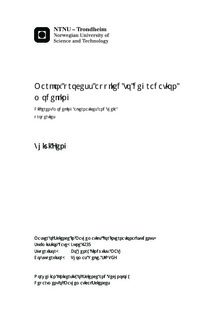Markov process applied to degradation modelling: Different modelling alternatives and their properties
Master thesis
Permanent lenke
http://hdl.handle.net/11250/259178Utgivelsesdato
2013Metadata
Vis full innførselSamlinger
Sammendrag
New scientific methods are required in industry to avoid loss of money and human lives and provide more profit. The purpose of this paper is to study stochastic models and statistical methods for analysis of lifetimes. Different alternatives of sequential continuous-time Markov-processes and semi-Markov process applied to modeling of technical degradation are considered, such as Markov processes similar to non-homogeneous Poisson process and semi-Markov process with sojourn time belonging to the Weibull distribution. A case study from an electrical network is performed. The object is an analysis of wood poles of power lines where the data from the company are panel data which contain observations over multiple time periods for the same individual pole. The wood poles are monitored by means of visual inspection techniques and their conditions are classified into five states, representing five different technical conditions. This paper describes how to predict the remaining lifetime given how long the poles have been in use and in which state they are observed. These corresponding Markov models are implemented in R-studio, parameters of the models are obtained based on the maximum likelihood methods. In order to compare and evaluate the models, likelihood ratio test statistics and hypothesis tests are applied. The simulations, based on the Markov models, are used to assess the quality of data and evaluate the goodness of models. Results from application of Markov models, discussion about advantages and disadvantages of the models, and suggestion are presented.
